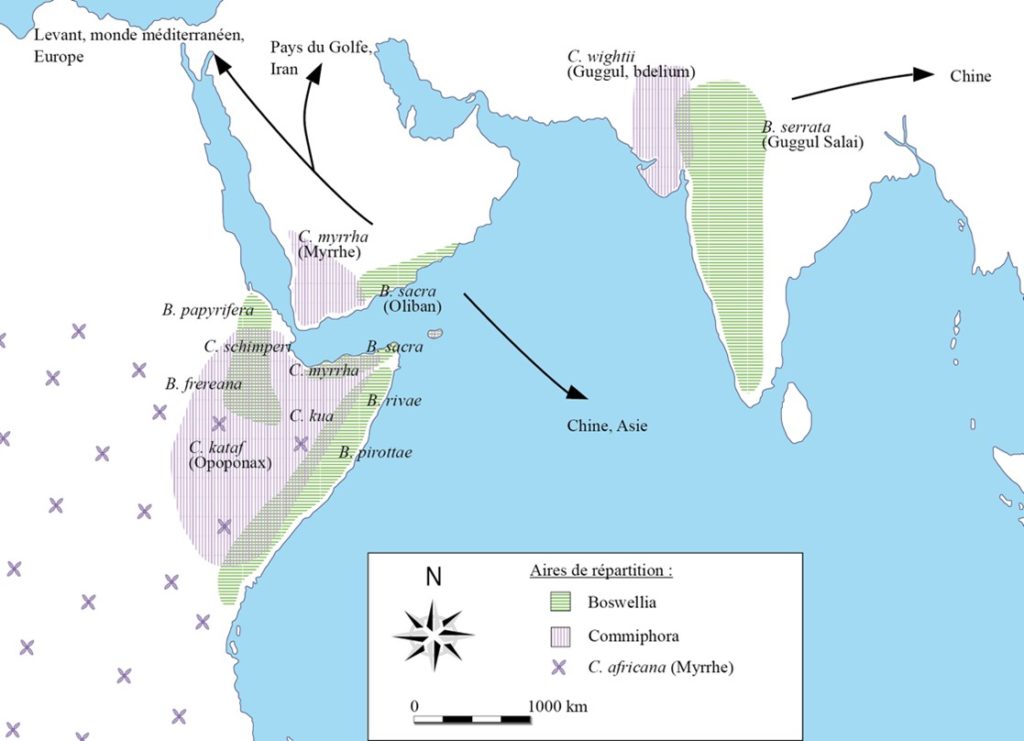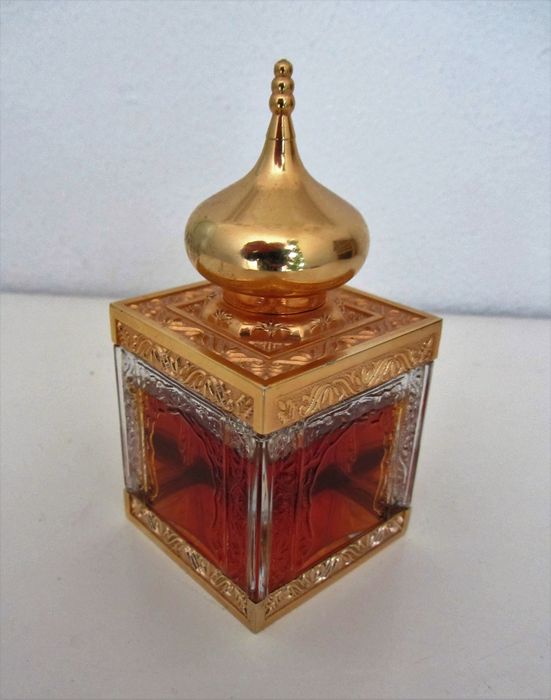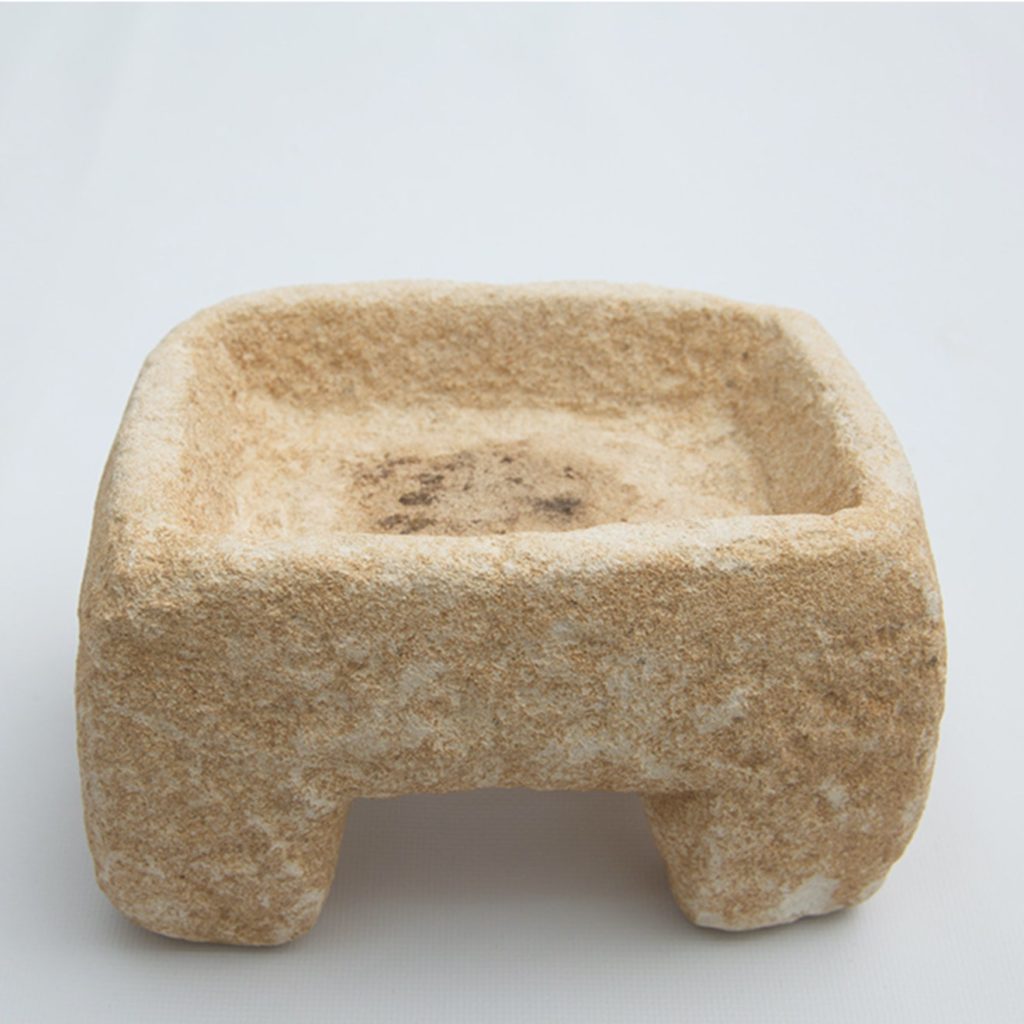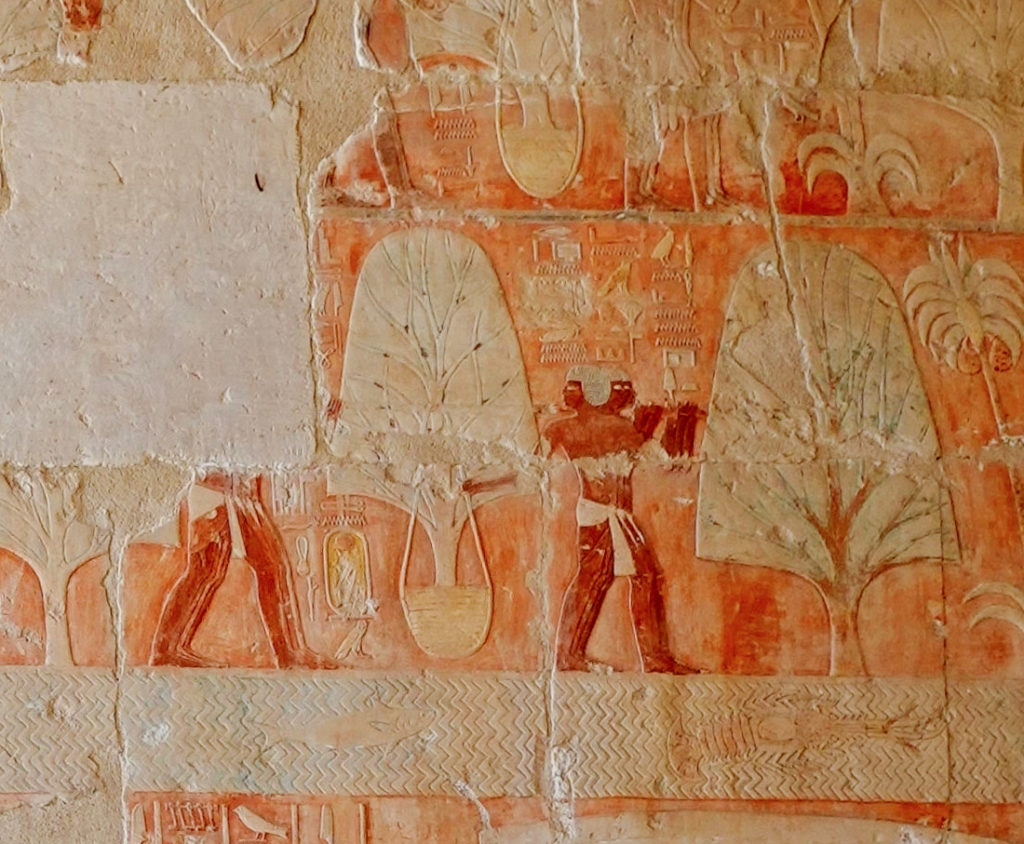An article written by Sterenn Le Maguer-Gillon
These words from Herodotus [1] sum up the imaginary world associated with southern Arabia, now Yemen, once called « Happy Arabia« , the land where the incense tree grows. Indeed, frankincense, so prized since Antiquity, is the resin from different species of the genus Boswellia, the most famous of which being Boswellia sacra, found in Yemen and the Dhofar region. Its use in religious rites will promote trade between southern Arabia and the Mediterranean world.

Distribution map of Boswellia (incense trees) and Commiphora (myrrh trees). © S. Le Maguer-Gillon
The use of incense has been attested at least since the Bronze Age. Indeed, a small stone incense burner with traces of combustion was found at the archaeological site of Ras al-Jinz (Sultanate of Oman), in a context dating from the 3rd millennium BC.
Left : incense burner found in Ras al-Jinz, Oman. 3rd millennium B.C. Right : Transport of incense trees. Bas-relief of the expedition to the land of Punt. Funerary temple of Hatshepsut at Deir el-Bahari. Beginning of the XVIIIth dynasty.
The first civilization eager for incense was Egypt. As early as the 3rd millennium, this product is attested in textual sources. The demand was so intense that Queen Hatshepsut (r. 1490-1468 B.C.) organized a naval expedition to the country of Punt (Horn of Africa or Yemen) to bring back incense trees. This episode is recounted in the famous frescoes of the temple of Deir el-Bahari in Egypt.
It was not until the turn of the first millennium B.C. that regular trade was established.

This trade responds to a growing demand for incense in the Mediterranean world, widely used in cults in the Levant and in Greece in particular. This trade was favored by a revolution : the domestication of the dromedary as a means of transport.
The incense route, starting in present-day Yemen and leading to Gaza, was born.
• • •
The incense trade was one of the factors that led to the emergence of the South Arabian kingdoms, the most famous of which is undoubtedly that of Sheba, to which the legend of the Queen of Sheba and King Solomon is attached. This kingdom, whose capital was Ma’rib, controlled the caravan route of incense.
The kingdom of Ma’în also played a key role in the transportation and marketing of aromatics, and Minaean merchants settled in Egypt and the Levant to trade. The kingdom of Hadramaut, whose capital was Shabwa, controlled the production of incense since the tree grew in its territory. This kingdom also developed maritime trade from the 4th century B.C. and founded ports such as Qanî’ and Sumhuram.

Map of ancient South Arabian sites. © S. Le Maguer-Gillon
Other regions benefited from this manna. The merchant kingdom of the Nabataeans grew rich thanks to the control of the northern part of the incense route, and founded its capital, Petra, in present-day Jordan. It also expanded further south, as evidenced by the remains of Hegra in the oasis of al-‘Ulâ in Saudi Arabia.
Maritime trade will continue to develop and, from the turn of our era, maritime exchanges intensify and allow regular trade to India.
• • •
When Islam appeared in Arabia in the 7th century, it was in the heart of a territory marked by the caravan trade and the transport of perfumes and other spices. Perfumes in general were highly valued by the Prophet Muhammad who is said to have declared « From your world (dunyā), I loved women and perfumes« .
In the Muslim world, perfumes are used in the form of fumigations (incense), scented waters or oils. The material culture, perfume burners and rose water sprinklers in particular, demonstrate this refinement.
In addition to the products available in Arabia, the elites will seek to obtain exotic substances such as musk or ‘ûd (agalloch wood) coming from the confines of Asia.

Thanks to their mastery of navigation and technical progress, Arab and Persian pilots took control of the Indian Ocean.
Illustration taken from Al-Harîrî’s Maqâmât (The Sessions). Copied and painted by Yahyâ b. Mahmûd al-Wâsitî, Baghdad, 1237. Manuscript on paper (167 leaves, 37 x 28 cm). BnF, Manuscripts (Arabic 5847 fol. 119).
On the other hand, imperial China made extensive use of frankincense for Buddhist rituals, to honor the emperor, and for funeral rites. This demand explains the lively trade in incense from Arabia throughout the Middle Ages and into the modern period.

Nowadays, the evocative power of incense has not weakened. It appears in the composition of several modern perfumes. In 1980, Guy Robert, a famous perfumer from Grasse in France, created an incense-based perfume called Amouage (« Wave ») at the request of Sultan Qaboos of Oman.
Several independent perfumers have also composed from this raw material, like Serge Lutens and his De Profundis evoking the atmosphere of a church.
[1] The exact quotation is : « From the land of Arabia comes an odor of marvelous sweetness« , Inquiry, Book III, 113.

Sterenn Le Maguer-Gillon is an archaeologist and art historian specializing in medieval Islam. She has supervised archaeological excavations in the Arabian Peninsula and Uzbekistan. She has taught art history and Islamic archaeology at the University of Paris 1. Since 2020, she has taught a course on « Arts, history and culture of the Arab-Persian world » at the Institut Catholique de Paris and an art history course entitled « Pluralities of cultural areas » at the Université Rennes 2.






